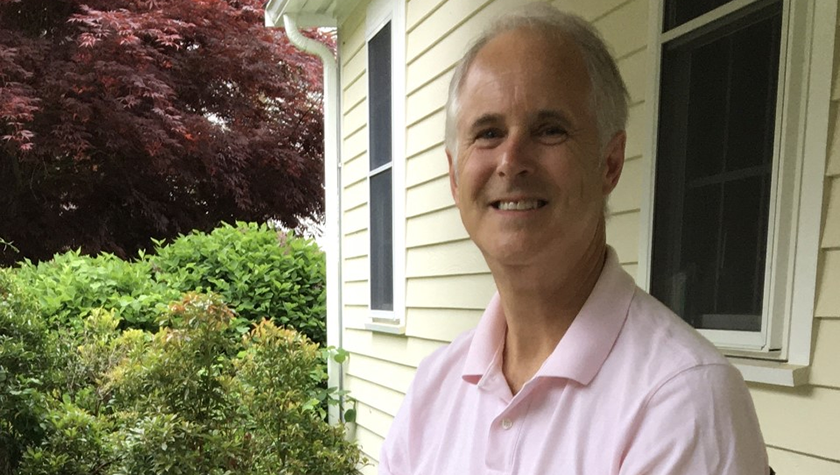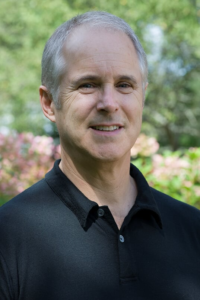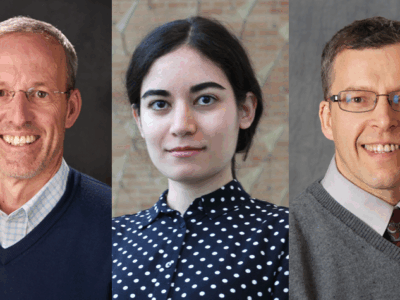
13
June

From biotech to the ongoing COVID-19 response, alum Mark Rogge is leading the charge
By Katie Ginder-Vogel
Today, precision medicine is an increasingly popular way to improve patient outcomes, tailoring therapy based on their specific demographic features and genotypes. But it was an emerging idea in pharmacy when Mark Rogge (BS ’82, MS ’84) was a student at the University of Wisconsin–Madison School of Pharmacy.
“At that time, we were just beginning to think about, for example, how someone in renal failure or with reduced liver function could be at greater risk of an adverse event because their body wasn’t clearing a drug as quickly as a typical patient,” says Rogge.
The work on patients in renal failure that he conducted through the Pharmaceutical Sciences master’s degree program set the stage for a career spent on the leading edge of research, first in precision medicine and then biotechnology.
“I wanted to have a career where I could focus on scientific discovery and also the application of that emerging science,” says Rogge. “I wanted to use that science to benefit the greater good.”
And he’s done just that, from helping to develop breakthrough drugs to treat multiple sclerosis to leading a team of researchers with their eyes on COVID-19 as the global head and vice president of translational sciences at Takeda Pharmaceutical Company Limited.
Getting started in personalized medicine
Rogge grew up in West Salem, a small farming community in Western Wisconsin, and visited UW–Madison for football weekends in the fall. He always knew he wanted to be a Badger.
“It was the only place I was interested in,” Rogge says. “The UW System was this amazing portal into breakthrough technology and science, and that was the direction in which I wanted to go.”
”Pharmacy education is the bridge between basic science and the products used by patients.”
—Mark Rogge
Once he arrived at UW–Madison as an undergraduate, Rogge’s fascination with chemistry, physics, and biology drove his aspirations and attracted him to pharmacy school.
Rogge’s pharmaceutics courses merged chemistry and physics, and he says the biology side of pharmacy challenged and inspired him.
“The discipline and perseverance necessary to get a pharmacy degree was significant, and that in itself was an education and something all of us who graduated carry throughout our careers,” says Rogge. “Equally important is that pharmacy gave us a foundational education on how patients will need to use our products and what is necessary to make that product a successful therapeutic intervention. Pharmacy education is the bridge between basic science and the products used by patients.”
After earning his pharmacy degree, he continued into a graduate program in Pharmaceutical Sciences, where he studied renal failure in the lab of Professor Peter Welling.
“We took a very hard look at patients who were in renal failure and undergoing peritoneal dialysis,” he says.
Those patients were often at risk of peritonitis — inflammation of the tissue that lines your abdomen and supports internal organs. Because vancomycin is used to treat peritonitis, Rogge’s research utilized vancomycin as an index molecule to understand how peritoneal dialysis could change the course of vancomycin exposure in the peritoneal cavity as well as exposure changes in systemic tissues. He sought to understand how renal failure alters drug disposition and how the peritoneal membrane under typical dialysis schedules affects therapeutic concentrations. This work explained the kinetics of peritoneal membrane transfer and how vancomycin dosing in these patients can be optimized to treat peritonitis.
In subsequent graduate school work his efforts focused on the characterization of the time-dependence of drug interactions. “We tried to create a dynamic mathematical characterization of CYP3A inhibition,” explains Rogge. CYP3A, Cytochrome P450, family 3, subfamily A, is a human gene locus.
“We were successful at describing the interaction using the index compound theophylline, which is metabolized by the CYP3A system. We gave inhibitors to understand how soon the interaction would become evident and also how long the drug interaction would progress into its most significant state,” he says. “It became evident that you won’t necessarily have an interaction on the first day; it might take much longer in some cases depending on various patient and drug factors. That had never really been critically described until then.”
Biotech boom
A few years after Rogge graduated with his PhD, which he earned in Michigan after completing his master’s degree at the UW–Madison School of Pharmacy, he joined Johnson & Johnson, finding himself in a large corporation for the first time, after years immersed in academic research.
“I had to learn how to get teams to come to decisions and to bring people from various areas together to make things happen,” he says. “It was a wonderful opportunity, and I developed important skills.”
When the company consolidated R&D facilities, Rogge left Johnson & Johnson to enter the biotechnology arena. He joined Biogen, a small Boston start-up, with no products on the market yet but bursting with intelligence and energy. One of the founders, who stayed actively engaged in Biogen’s R&D activities, was Nobel laureate Phil Sharp.
“There were many brilliant scientists,” Rogge says. “Every day, I was learning more about molecular biology, glycoprotein chemistry, and immunology. I spent time at Harvard and MIT taking courses. It was an unbelievable time of professional development, like getting another PhD — only harder.”
In the 1990s, Biogen and other biotech companies like Amgen, Genentech, and Genzyme, all driven by prominent scientists, were trying to find ways to make recombinant proteins that had only ever been used as reagents for in vitro studies and rodent studies into human drugs.

“And that was a fascinating challenge,” says Rogge. “We then had the emerging technology to actually measure how much of the drug was getting to the site of action and to what extent it was producing the effect we wanted in those cells and tissues. We could measure those events and then create dose-response characterizations, which gave us the opportunity to rationalize how the glycoprotein could be safely used in humans.”
In 1996, Biogen’s product Interferon beta 1a, brand name Avonex™, was the first product approved to reduce the progression of neuromuscular degeneration in multiple sclerosis patients. Later, Rogge was a core member of the Spinraza™ and Tecfidera™ teams, which treat spinal muscular atrophy and relapsing multiple sclerosis, respectively.
In late 1999, Rogge joined Immunex in Seattle, another emerging biotech company that was beginning to gather promising data on Enbrel™, etanercept, in rheumatoid arthritis.
“Once again, I was thrust into an amazing ecosystem of brilliant scientists, who were working to understand the pathology of inflammation and the pharmacology of this product,” says Rogge. “We were able to look at a multitude of indications to see if we could reduce the severity of diseases like juvenile rheumatoid arthritis, ankylosing spondylitis, and psoriatic arthritis. We hit home runs with each of those indications.”
When Immunex was acquired, Rogge literally crossed the street to join the startup biotech firm ZymoGenetics, where he headed up the preclinical and clinical pharmacology areas.
“As an industry, we were able to apply remarkable technology and deep insight into physiology, pathology, and pharmacology, and this biotechnology era opened up the realm of systems pharmacology, where we can look at how the drug is working at the cell level and how those changes within the affected tissue can ultimately change the outcome of the disease,” Rogge says.
As the government was trying to figure out how to regulate biotechnology throughout this decade, healthy collaborations between the biotech companies and the U.S. Food and Drug Administration were important.
“We were truly partners,” says Rogge, who is a member of FDA’s Pharmaceutical Science and Clinical Pharmacology Advisory Committee. “It was a trusting, great relationship that developed and has persisted, and it comes from the FDA’s interest in, and excitement about, science. One example that stands out was the development of a scientific roadmap to create “generic” forms of biotechnology products. The FDA began to create standards around biosimilars, which many of us knew were a future reality. I was able to do a lot of work to determine what a safe and efficacious biosimilar could look like and have those principles reflected in our current biosimilar regulations.”
Rogge says he sees the same exciting developments he experienced in early biotech happening again now in the fields of gene therapy and cell therapy.
“There will be phenomenal opportunities; we will see a lot going on in the next 10 years,” says Rogge. “My advice to anyone involved in pharmacy is also to become involved in the larger system in which you work — with other companies (collaborations, consortia) and with regulatory agencies. It’s vitally important because this is such an emerging area.”
Translational science in the time of COVID
Rogge joined Takeda to lead global translational science activities and serves on the research senior leadership team. His role is focused on bringing deeper biological insight and subsequent clinical success to the global R&D portfolio which includes traditional small molecules, complex glycoproteins, gene and cell therapy modalities.
“Takeda is 239 years old and global, and yet it operates very much like a biotechnology company in 1995 — highly agile, full of energy and excitement,” says Rogge.
As global head of translational science at Takeda, Rogge oversees systems pharmacology, advanced modeling and simulation, biomarker innovation and development, clinical pharmacology, and imaging.
“Takeda has a deep spirit of applying foundational science to very serious illness, ranging from oncology to rare disease,” says Rogge. “It’s exciting because the scope of our work initiates at the moment a new disease target is identified, all the way out to when hundreds of thousands of patients are potentially being treated with the commercial drug.”
Rogge’s days are generally filled with assessing emerging data and results and working with senior leadership to understand if there is a need to make a course correction or apply resources differently. He also serves on portfolio joint steering committees and the scientific advisory board for the Tri-Institutional Therapeutics Discovery Institute.
“The PharmD is not an end in itself. It’s a beginning that’s driven by your ambitions, your creativity, and your interests.”
—Mark Rogge
Takeda is currently taking on the COVID-19 pandemic by collaborating with other companies and consortia. Rogge says the pursuit of transformative COVID-19 therapies has become his second job.
“It’s been exciting and has made my multifaceted role even more challenging,” he says. “We’re still fully focused on keeping our original portfolio moving forward in each therapeutic area, and now, we’re trying to make the COVID-19 opportunities in our portfolio just as successful.”
Rogge says Takeda has been working with partners and is now beginning clinical trials with an anti-SARS-CoV-2 polyclonal hyperimmune globulin. Polyclonal hyperimmune globulins are plasma-derived therapies that have been used to treat severe illnesses like H1N1, SARS, Ebola, and even diphtheria.
“Anti-SARS-CoV-2 immunoglobulins are obtained from patients who have recovered from the disease and are then concentrated into a clinical dosage form; it’s an experimental treatment that can be given to recently diagnosed patients who may be at higher risk of more severe adverse events or who are starting to exhibit acute respiratory distress,” says Rogge. “I’m very excited that this therapy could potentially target the most serious aspects of this disease.”
Takeda is also looking at ways to repurpose their existing marketed products as well as new molecular entities in their portfolio to confront the COVID-19 pandemic. Already, four priority clinical assets are being assessed and several others are being considered.
Giving back
As part of his commitment to the UW, Rogge’s connections to the School of Pharmacy as an alumnus run deep. He has served on the leadership committee for the Annual Drug Metabolism and Applied Pharmacokinetics Land O’ Lakes conference and as a lecturer for a short course on drug development, through the School’s Division of Pharmacy Professional Development. He also received a Citation of Merit in 2015 and recently joined the School’s Board of Visitors to help guide the future of pharmacy education.
“Serving on the Board of Visitors is a rare opportunity,” Rogge says. “It comes at a time when revolutionary changes are occurring in the complexity and promise of new therapies and the delivery of these therapies to patients. I look forward to offering ideas that further the success of the School, the students, and our pharmacy profession.”
And that future looks bright, he says.
“The PharmD is not an end in itself,” Rogge adds. “It’s a beginning that’s driven by your ambitions, your creativity, and your interests.”




